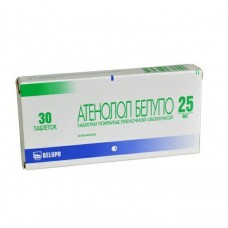Expiration date: 09/2026
The composition and form of issue:
Tablets. 1 tablet contains atenolol 25, 50 or 100 mg
Excipients: starch (dry) methylparaben propylparaben magnesium stearate sodium starch of glycolate silicon dioxide colloidal calcium phosphate dibasic talc
in a contour acheikova packing 10, 14 or 20 PCs. in cardboard pack 1, 2, 3, 4, 5, 7 or 10 packs.
Feature:
Cardioselective beta1-blocker.
Pharmacokinetics:
Atenolol is rapidly absorbed, although not completely (50%) from the gastrointestinal tract. Cmax of the drug in the blood is 2-3 hours after ingestion. Atenolol slightly bound to plasma proteins. T1/2 of the drug is 6-7 hours Atenolol is almost completely excreted from the body unchanged (nematerializiranih) in the urine (85-100%). Very poorly crosses the GEB. Penetrates through the placental barrier and is excreted in breast milk.
Description pharmacological action:
Reduces automaticity sinusnogo unit urejaet curves, slowing AV conduction, reduces myocardial contractility, reduces the need of myocardium in oxygen. Reduces the excitability of the myocardium. When used in the medium therapeutic doses it has a less pronounced effect on smooth muscles of the bronchi and peripheral arteries than non-selective beta-blockers.
Indications:
- hypertension
- preventing attacks of angina (with the exception of strokes Prinzmetala)
- cardiac arrhythmias (sinus tachycardia, prevention of supraventricular tachyarrhythmias)
- neurocirculatory dystonia on hypertonic type.
Contraindications:
- hypersensitivity to the drug
- AV blockade II–III degree
- syndrome weakness sinusnogo hub
- cardiogenic shock
- acute heart failure
- bradycardia
- hypotension in myocardial (garden of <100 p="">,
- chronic heart failure II B–III stage
- sinoaurikuliarnaya blockade
- metabolic acidosis
- bronchial asthma
- the combination with MAO inhibitors
- children up to age 18 years.
Application of pregnancy and breast-feeding:
Pregnant women should be assigned to Atenolol only in those cases where the benefit to the mother outweighs the potential risk to the fetus.
Atenolol is excreted in breast milk, so breast-feeding should be adopted only in exceptional cases with great care.
Side effects:
The most common side effects associated with the main pharmacological action of the drug and are expressed as follows.
From the side of cardiovascular system: symptoms of heart failure, impaired AV conduction, bradycardia, hypotension, feeling cold and paresthesias in the extremities.
CNS: dizziness, insomnia, decreased ability to concentrate, drowsiness, depression, hallucinations, lethargy, fatigue, headache.
On the part of the digestive tract: dry mouth, nausea, vomiting, diarrhea, abdominal pain, constipation
The respiratory system: dyspnea, bronchospasm, apnea.
Hematologic reactions: thrombocytopenic purpura, anemia (aplastic), thrombosis.
From the endocrine system: gynecomastia, reduced potency, decreased libido
Reactions metabolic: hyperlipidemia, hypoglycemia
With the skin: urticaria, dermatitis, itching, photosensitivity.
Drug interactions:
Combined with aminophylline and theophylline, probably mutual suppression of therapeutic effects.
While the use of Atenolol with insulin, hypoglycemic agents hypoglycemic their effect is amplified.
When used together with antihypertensive drugs of different groups or nitrates there is a strengthening of the hypotensive action. Concurrent use of Atenolol and verapamil (or diltiazem) can cause mutual strengthening cardiodepressivne action.
In concurrent usage of Atenolol and cardiac glycosides increases the risk of bradycardia and violations of AV conduction.
When concomitant administration of Atenolol with rezerpinom, metildopoj, clonidine, verapamil may cause severe bradycardia.
While taking Atenolol derivative of ergotamine, xanthine, NSAIDs, their effectiveness is reduced.
Upon the termination of the combined use of Atenolol and clonidine clonidine treatment continued for several days after discontinuation of Atenolol.
Simultaneous application with lidocaine can reduce its removal and increase risk of toxic effect of lidocaine.
Use in conjunction with phenothiazine derivatives, enhances the concentration of each of the drugs in serum.
Contraindicated simultaneous application with MAO inhibitors.
Method of application and dose:
Inside, before eating, do not chew, washed down with a small amount of liquid. The dosage regimen set individually.
Hypertension
Treatment start with 25-50 mg of Atenolol 1 per day. To achieve stable hypotensive effect requires 1-2 weeks of admission. The lack of symptoms gipotenzivnogo effect dose increase to 100 mg per single dose. Further dose increase is not recommended, because not accompanied by increased clinical effect.
Angina
Initial dose of 25-50 mg per day. If during the week not achieved the optimal therapeutic effect, increase the dose to 100 mg/day for 1 or 2 admission.
Elderly patients and patients with impaired renal excretory function require correction of dosing regimen.
In the presence of renal insufficiency recommend dose adjustment depending on creatinine clearance.
When Cl creatinine values above 35 ml/min/1.73 m2 (normal values are 100-150 ml/min/1.73 m2), significant accumulation of Atenolol occurs.
The table shows the maximum recommended dose for patients with renal insufficiency.
Table
| Creatinine clearance, ml/min/1,73?2 | The half-life time, h | Maximum dose |
| 15–35 | 16–27 | 50 mg per day |
| <,15 td="">, | >,27 | 50 mg a day |
Patients who are on hemodialysis, is prescribed Atenolol 50 mg/day immediately after each dialysis. The reception should be carried out in stationary conditions, as it can be drop in blood pressure.
For secondary prevention of myocardial infarction is 100 mg 1 time per day or 50 mg 2 times a day for 6-9 days or until discharge from the hospital.
In functional disorders of the cardiovascular system is recommended to be applied Atenolol in the dose of 25 mg per day.
Overdose:
Symptoms: bradycardia, atrioventricular block II and III degree increase in symptoms of heart failure, hypotension, bronchospasm, hypoglycemia.
If you have symptoms of overdose immediately contact your doctor.
Treatment: When expressed bradikardii shown intravenous administration of 1 ml of 0.1 % solution of atropine sulfate.
AV blockade II and III extent possible appointment of isoprenaline tablets 5 mg under the tongue (if necessary, repeat in 2-4 h) or in/to drip or slow bolus at a dose of 0.5–1 mg If you experience bronchoconstriction beta2-agonists.
Special instructions:
In patients with coronary artery disease, abrupt withdrawal of beta-blockers may cause an increase in the frequency or severity of anginal attacks, so cease taking Atenolol patients with coronary artery disease need to be gradual.
Special attention requires the selection of doses in patients with decompensation. Compared to non-selective beta-blockers, cardioselective beta-blockers have less effect on lung function, however, in obstructive diseases of the respiratory tract Atenolol should be prescribed only in case of absolute indications. If necessary, the appointment in some cases it is possible to recommend the use of beta2-agonists.
Atenolol mask the tachycardia occurring with hypoglycemia, and can increase the duration of hypoglycemic reaction to insulin. Caution should be exercised with simultaneous use of Atenolol, and of hypoglycemic drugs in diabetic patients.
Special attention is necessary in cases where a surgical intervention under General anesthesia in patients taking Atenolol. The drug should be discontinued 48 hours before surgery. As an anesthetic, you should choose the drug with minimal negative inotropic effects.
Caution should appoint drug in patients with psoriasis, pheochromocytoma, hyperthyroidism and severe myasthenia gravis, Raynaud's disease and various occlusive diseases of peripheral arteries, patients with severe disorders of renal excretory function.
With simultaneous use of clonidine and Atenolol, taking Atenolol stop for a few days before clonidine to avoid withdrawal symptoms last.
If necessary, I/V administration of verapamil, it should be done at least 48 hours after taking the Atenolol.
In applying Atenolola may decrease the production of tear fluid, which is important for patients who use contact lenses.
Atenolol should be wary designate drivers of vehicles and persons working with machinery, due to possible lack of focus.


